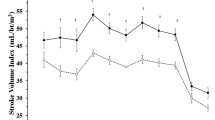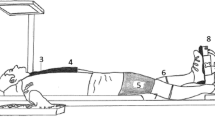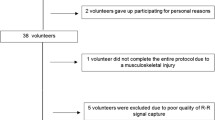Summary
The effects on heart rate, blood pressure, and plasma catecholamines (epinephrine, norepinephrine, dopamine) of sustained isometric contraction (SIC) were studied in six women and nine men. Each subject held a tension equivalent to 30% of maximal handgrip strength until exhaustion. There were no significant differences between women and men in the duration of handgrip. Rise of heart rate and blood pressure were similar for women and men. Considering the absolute plasma levels of each catecholamine, no sex differences was observed at rest and at any time during SIC, except for epinephrine whose concentration was higher in men at first min of SIC. On the other hand, women and men exhibited different adrenergic patterns in response to SIC: in the first min of exercise the plasma level of the three catecholamines increased in men whereas for women plasma catecholamines levels were essentially unaffected. Thus, epinephrine seems to play a minor role in the regulation of heart rate and blood pressure during SIC for women. Another interesting result of our study is that SIC is able to induce an increase in dopamine plasma level for women as well as for men.
Similar content being viewed by others
References
Alam M, Smirk FH (1937) Observations in man upon a blood pressure raising-reflex arising from the voluntary muscles. J Physiol (Lond) 89: 372–383
Alam M, Smirk FH (1938) Observations in man on a pulse-accelerating reflex from the voluntary muscles of the legs. J Physiol (Lond) 92: 167–177
Borst C, Hollander AP, Bouman LN (1972) Cardiac acceleration elicited by voluntary muscle contractions of minimal duration. J Appl Physiol 32: 70–77
Claustre J, Peyrin L, Fitoussi R, Mornex R (1980) Sex differences in the adrenergic responses to hypoglycemic stress in human. Psychopharmacology 67: 147–153
Crowley WR, O'Donohne TL, Jacobowitz DM (1978) Sex differences in catecholamine content in discrete brain nuclei of the rat. Effects of neonatal castration or testerone treatment. Acta Endocrinol 89: 20–28
Da Prada M, Zürcher G (1976) Simultaneous radioenzymatic determination of plasma and tissue adrenaline, noradrenaline and dopamine within the femto-mole range. Life Sci 19: 1161–1174
Ekblom B, Goldbarg AN, Kilbom A, Astrand PO (1972) Effects of atropine and propranolol on the oxygen transport system during exercise in man. Scand J Clin Lab Invest 30: 35–42
Fernandez BE, Dominguez AE, Vidal NA (1973) Catecholamines thyroid function and the sexuel cycle in rats. Acta Endocrinol 73: 273–281
Few JD, Imms FJ, Weiner JS (1975) Pituitary adrenal response to static exercise in man. Clin Sci Mol Med 49: 201–206
Frankenhaeuser M, Dunne E, Lundberg U (1976) Sex differences in sympathetic-adrenal medullary reactions induces by different stressors. Psychopharmacology 47: 1–5
Fredhom BB, Farnebo LO, Hamberger B (1979) Plasma catecholamines, cyclic AMP, and metabolic substrates in hemorrhagic shock of the rat. The effect of adrenal demedullation and 6-OH-dopamine treatment. Acta Physiol Scand 105: 481–495
Freyschuss U (1970) Cardiovascular adjustment to somatomotor activation. Acta Physiol Scand [Suppl] 342: 1–63
Goodwin GM, McCloskey DI, Mitchell JH (1972) Cardiovascular and respiratory responses to changes in central command during isometric exercise at constant muscle tension. J Physiol (Lond) 226: 173–190
Gordon JH, Shellenberger MK (1974) Regional catecholamine content in the rat brain: sex differences and correlation with motor activity. Neuropharmacology 13: 129–137
Hervonen A, Alho H, Helen P, Kanerva L (1979) Small, intensely fluorescent cells of human sympathetic ganglia. Neurosci Lett 12: 97–101
Humphreys PW, Lind AR (1963) The blood flow through active and inactive muscles of the forearm during sustained hand-grip contractions. J Physiol (Lond) 166: 120–135
Johansson G (1972) Sex differences in the catecholamine output of children. Acta Physiol Scand 85: 569–572
Johansson G, Post B (1974) Catecholamine output of males and females over one-year period. Acta Physiol Scand 92: 557–565
Kozlowski S, Brezinska Z, Nazar K, Kowolski W, Franczyk M (1973) Plasma catecholamines during sustained isometric exercise. Clin Sci Mol Med 45: 723–731
Krogh A, Lindhard J (1913) The regulation of respiration and circulation during the initial stages of muscular work. J Physiol (Lond) 47: 112–136
Kvetnansky R, Weise VK, Kopin IJ (1979) The origins of plasma epinephrine, norepinephrine, and dopamine levels in stressed rats. In: Usdin E, Kopin OJ, Barchars I (eds) vol 1. Pergamon Press, Oxford New York, pp 684–686
Lake CR, Ziegler MG, Kopin IJ (1976) Use of plasma norepinephrine for evaluation of sympathetic neuronal function in man. Life Sci 18: 1315–1326
Libet B, Tosaka T (1970) Dopamine as a synaptic transmitter and modulator in sympathetic ganglia. A different mode of synaptic action. Proc Natl Acad Sci USA 67: 667–673
Lind AR, McNicol GW, Bruce RA, McDonald HR, Donald KW (1968) Cardiovascular responses to sustained contractions of a patient with unilateral syringomyelia. Clin Sci 35: 45–53
Lind AR, Taylor SH, Humphreys PW, Kennelly BM, Donald KW (1964) The circulatory effects of sustained voluntary muscle contraction. Clin Sci 27: 229–244
Martin CE, Shaver JA, Leon DF, Thompson ME, Reddy PS, Leonhard JJ (1974) Autonomic mechanisms in hemodynamic responses to isometric exercise. J Clin Invest 54: 104–115
McCloskey DI, Mitchell JH (1972) Reflex cardiovascular and respiratory responses originating in exercising muscle. J Physiol (Lond) 224: 173–186
Mc Dermott DJ, Stekiel WJ, Barboreak JJ, Kloth LC, Smith JJ (1974) Effects of age on hemodynamic and metabolic response to static exercise. J Appl Physiol 37: 923–926
Monod H (1956) Contribution à l'étude du travail statique. Thèse Doct Med, Paris, Foulon, Paris
Nazar K, Chwalbińska-Moneta L, Zukowska-Grójec Z (1979) Plasma noradrenaline response to sustained handgrip in patients with essential hypertension. Eur J Appl Physiol 41: 181–185
Patkai P, Johannson G, Post B (1974) Mood, alertness, and sympathetic-adrenal medullary activity during the menstrual cycle. Psychosom Med 36: 503–512
Pequignot JM, Peyrin L, Maiyet MH, Flandrois R (1979) Metabolic adrenergic changes during submaximal exercise and in the recovery period in man. J Appl Physiol 47: 701–705
Petrofsky JS, Burse RL, Lind AR (1975) Comparison of physiological responses of women and men to isometric exercise. J Appl Physiol 38: 863–868
Peyrin L, Cottet-Emard JM, Javoy F, Agid Y, Herbet A, Glowinski J (1978) Long-term effects of unilateral 6-hydroxydopamine destruction of the dopaminergic nigrostriatal pathway on the urinary excretion of catecholamines (dopamine, norepinephrine, epinephrine) and their metabolites in the rat. Brain Research 143: 567–572
Rogowsky M, Vander Putten M, Heyters Ch, Degree S (1978) Analyse de la contrainte musculaire dynamique et statique chez l'homme et chez la femme au cours d'un travail à faible dépense énergétique. Trav Hum 41: 210–223
Sampson SR, Nicolaysen G, Jaffe RA (1975) Influence of centrifugal sinus nerve activity on carotid body catecholamines. Microphotometric analysis of formaldehyde induced fluorescence. Brain Res 85: 437–446
Tuttle WW, Horwath SM (1957) Comparison of effects of static and dynamic work on blood pressure and heart rate. J Appl Physiol 10: 294–296
Van Loon GR, Schwartz L, Sole MJ (1979) Plasma dopamine responses to standing and exercise in man. Life Sci 24: 2273–2278
Wiechman BE, Borowitz JL (1979) Effects of steroid hormons and diethylstilbestrol on adrenomedullary catecholamine secretion. Pharmacology 18: 195–201
Wiley RL, Lind AR (1971) Respiratory responses to simultaneous static and rhythmic exercises in humans. Clin Sci Mol Med 49: 427–432
Zacur HA, Tyson JE, Lake CR (1978) Plasma dopamine-Β-hydroxylase activity and norepinephrine levels during the human menstrual cycle. Am J Obstet Gynecol 130: 148–151
Zuspan FP, Zuspan KJ (1973) Ovulatory plasma amine (epinephrine and norepinephrine) surge in the woman. Am J Obstet Gynecol 117: 654–661
Author information
Authors and Affiliations
Rights and permissions
About this article
Cite this article
Sanchez, J., Pequignot, J.M., Peyrin, L. et al. Sex differences in the sympatho-adrenal response to isometric exercise. Europ. J. Appl. Physiol. 45, 147–154 (1980). https://doi.org/10.1007/BF00421322
Accepted:
Issue Date:
DOI: https://doi.org/10.1007/BF00421322




